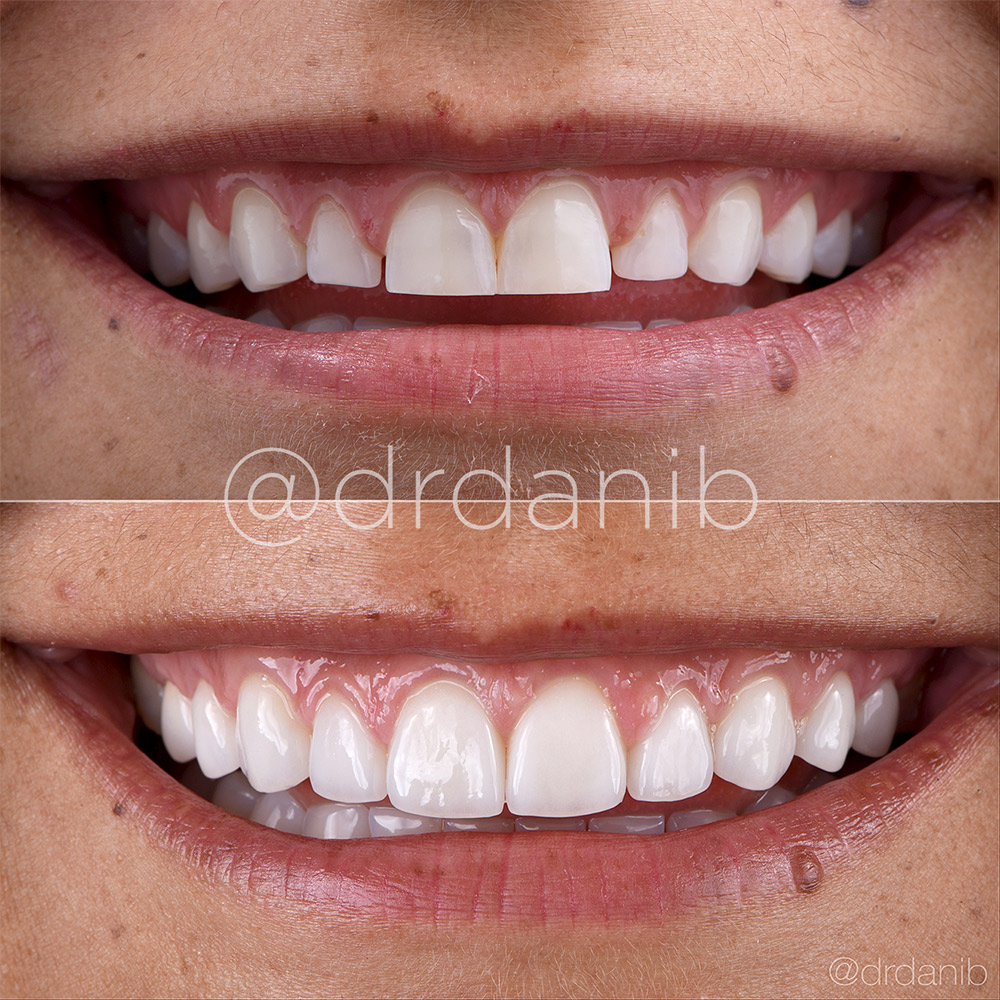Unlocking the Tricks of Veneers: Truths, Types, and Benefits for a Beautiful Smile
Veneers use an engaging service for those looking for to improve their smiles. These oral enhancements can address different imperfections, from discoloration to imbalance. With options like porcelain and composite, individuals can choose based on their preferences and requirements. However, recognizing the nuances of veneers, including application and care, is essential. What elements should one take into consideration before deciding? The answers might surprise those curious about this visual oral option.

Recognizing Veneers: What Are They?
Veneers are thin, customized shells designed to cover the front surface area of teeth, improving their appearance. Usually crafted from sturdy materials, these coverings are customized to fit each person's teeth specifically. They serve several functions, consisting of fixing aesthetic flaws such as discoloration, chips, or spaces. The application procedure involves a dental practitioner preparing the teeth, usually by removing a little quantity of enamel to assure a snug fit. As soon as prepared, the veneers are bound to the teeth using a strong adhesive.
Individuals frequently pick veneers for their ability to develop a natural-looking smile while providing a durable solution to oral flaws. Unlike various other aesthetic dentistry alternatives, veneers require marginal intrusive treatments, making them a popular option. The result is an enhanced smile that can significantly improve an individual's confidence and self-confidence. On the whole, veneers offer an effective technique to attaining a much more attractive and unified dental appearance.
Types of Veneers: Porcelain vs. Compound
When thinking about cosmetic oral options, two primary sorts of veneers stand out: porcelain and compound. Porcelain veneers are crafted from a resilient ceramic material that imitates the natural appearance of teeth. They are known for their discolor resistance and capacity to mirror light in a similar way to natural enamel, offering an aesthetic appeal that several people wish. The application process typically involves even more preparation of the tooth structure and might require multiple check outs to the dental practitioner.
On the various other hand, composite veneers are made from a tooth-colored material that is straight used to the teeth. This type permits quicker application and can often be finished in a solitary check out. While they are cheaper than porcelain veneers, they might not provide the same durability or resistance to staining. Ultimately, the choice in between porcelain and composite veneers depends upon private choices, spending plan, and specific dental requirements.
The Benefits of Deciding On Veneers
Choosing veneers provides countless benefits that can significantly improve both the aesthetics and functionality of an individual's smile. Among the main benefits is their capacity to remedy flaws such as discoloration, spaces, and imbalance, resulting in a much more consistent appearance. Veneers can also boost the longevity of teeth, providing a safety layer that guards them from damage.
In addition, they require minimal tooth prep work contrasted to various other dental treatments, maintaining more of the natural tooth structure. This conservation adds to a much healthier oral environment while still attaining a spectacular smile.
Veneers are highly adjustable, permitting people to pick the shape, dimension, and shade that ideal suits their preferences. Furthermore, they are stain-resistant, making it much easier to preserve a brilliant and attractive smile in time. On the whole, veneers present an effective option for those looking for both aesthetic enhancement and long-lasting oral health and wellness advantages.
The Veneer Application Process
The veneer application process involves several vital actions to ensure optimal results. Originally, an assessment is carried out to examine the individual's needs, adhered to by the prep work and shaping of the teeth. Finally, the veneers are bound in area, with changes made for a best fit and look.
First Appointment Tips
A thorough initial appointment is necessary for any person thinking about veneers, as it establishes the foundation for a successful treatment. During this conference, the dental professional evaluates the individual's dental wellness, reviewing any existing concerns that can influence the veneer application. This analysis might consist of X-rays and an aesthetic assessment to identify the condition of the teeth and periodontals.
The dental professional also involves the individual in a thorough conversation concerning their aesthetic goals, preferences, and expectations. They might present different veneer alternatives tailored to the patient's specific requirements. In addition, the expert describes the treatment, potential risks, and aftercare needs, making sure that the individual is well-informed and comfy before waging the treatment.
Preparation and Forming Teeth
After the preliminary consultation, the following phase includes the prep work and shaping of the teeth to accommodate the veneers. This essential step is performed by the dental practitioner, that meticulously analyzes the tooth structure to determine the quantity of enamel that needs to be gotten rid of. Usually, a thin layer, typically around 0.5 millimeters, is slashed off to ensure a proper suitable for the veneers. Precision is critical throughout this process, as it impacts both the visual end result and the general comfort. As soon as the teeth are sufficiently formed, perceptions are required to produce custom-made veneers that line up flawlessly with the client's oral account. This thorough preparation establishes the stage for a successful veneer application, improving both look and function.
Bonding and Final Adjustments
Adhering to the shaping and prep work of the teeth, the bonding procedure starts, noting a vital phase in the veneer application. Throughout this stage, an oral adhesive is related to the prepared tooth surface area, guaranteeing a strong bond between the veneer and the tooth. The dental practitioner diligently positions the veneer, making modifications to achieve the wanted alignment and visual appeals. Once effectively positioned, an unique light is utilized to heal the adhesive, strengthening the bond. After curing, the dental expert performs last changes, cutting any kind of excess material and improving the veneer's shape to assure a natural appearance. This careful focus to detail boosts both feature and aesthetic appeals, adding to a total beautiful smile that is durable and lasting.
Taking care of Your Veneers: Maintenance Tips
Caring for veneers is vital to maintain their appearance and long life. A regular daily cleansing regimen, mindful avoidance of staining foods, and regular oral exams are crucial components of efficient upkeep. These methods aid assure that veneers remain in peak problem and proceed to boost one's smile.
Daily Cleaning Routine
Routinely maintaining veneers is important for their durability and look. A proper daily cleansing regimen can aid protect their shine and protect against damages. Dental practitioners advise brushing twice a day with a soft-bristled toothbrush and fluoride tooth paste, guaranteeing that all surface areas are cleaned up gently to avoid damaging the veneer surface. Flossing everyday is also vital to get rid of food particles and plaque from between teeth, where brushes may not reach. Furthermore, utilizing an antimicrobial mouth wash can aid preserve oral hygiene without harming the veneers. It is a good idea to stay clear of unpleasant cleaners and devices that can scrape the veneer. By complying with these simple actions, individuals can keep their veneers looking beautiful while advertising total dental health and wellness.
Preventing Staining Foods
Veneers are made to enhance the appearance of teeth, their vulnerability to staining demands cautious dietary selections. It see page is essential for people with veneers to be conscious of specific foods and beverages that can lead to discoloration. Dark-colored items such as coffee, red a glass of wine, and berry juices need to be eaten in small amounts, as they are understood to discolor both natural teeth and veneers. Additionally, acidic foods like citrus fruits container weaken the bonding representatives utilized in veneers, making them a lot more susceptible to discoloration. To keep a bright pop over here smile, it is suggested to rinse the mouth with water after consuming discoloration foods and to exercise regular dental hygiene. These thoughtful options add significantly to the durability and aesthetics of veneers.

Regular Dental Exams

Keeping the honesty of veneers needs a commitment to normal dental exams, as these appointments play an essential role in ensuring their long life and look. Throughout these visits, oral specialists can analyze the problem of the veneers, checking for any kind of indications of wear, damage, or underlying dental problems. Additionally, regular cleanings aid get rid of plaque and tartar that can accumulate around the veneers, promoting overall oral health and wellness. Dental experts can also supply personalized suggestions on treatment methods and items matched for veneer upkeep. By sticking to a timetable of exams, individuals can address potential issues early, guaranteeing their smile stays vibrant and lovely. Ultimately, normal oral brows through are a vital part of veneer treatment.
Is Veneers the Right Option for You?
Making a decision whether veneers are the right alternative commonly rests on private oral needs and aesthetic objectives. For those seeking to deal with concerns such as staining, chips, or imbalance, veneers can provide a transformative solution. Prospects generally include individuals with healthy and balanced teeth but want a boosted smile.
It is essential to take right into account variables such as tooth enamel problem, the extent of oral issues, and the readiness to maintain veneers. Consulting with an oral specialist is vital, as they can assess dental wellness and identify if veneers appropriate
Furthermore, possible candidates ought to review the long-lasting commitment, as veneers might need replacement every 10-15 years. Price considerations likewise play a considerable duty, as veneers can be a substantial investment. Inevitably, the choice ought to be well-informed, balancing aesthetic wishes with sensible factors to consider for lasting results.
Often Asked Concerns
The Length Of Time Do Veneers Generally Last Prior To Requiring Replacement?
Veneers commonly last in between 10 to 15 years prior to requiring substitute. Elements such as oral health, way of living selections, and material top quality can affect their durability, making routine oral check-ups vital for maintaining their problem.
Are Veneers Safe for People With Delicate Teeth?
Veneers can be safe for people with delicate teeth, however it often depends upon the severity of level of sensitivity and the dentist's technique. Consulting a dental professional prior to continuing is necessary to ensure suitable results.
Can Veneers Be Gotten Rid Of or Replaced Conveniently?

Do Veneers Spot Gradually, and Just How Can I Avoid It?
Veneers can discolor over time, especially from foods and beverages like coffee or red a glass of wine. To avoid discoloration, maintaining good dental hygiene, using a straw for drinks, and regular oral cleansings are advised techniques.
What Is the Cost Variety for Obtaining Veneers?
The price of veneers generally varies from $500 to $2,500 per tooth, depending upon elements such as product type, dental professional experience, and area. Clients should seek advice from with oral professionals for personalized quotes and financing choices.
Once the teeth are sufficiently shaped, impressions are taken to develop personalized veneers that straighten completely with the patient's oral account. During this stage, click for info an oral adhesive is applied to the ready tooth surface area, ensuring a strong bond in between the tooth and the veneer. It is essential to take into account elements such as tooth enamel condition, the extent of dental issues, and the readiness to preserve veneers. Veneers can be secure for individuals with sensitive teeth, but it often depends on the intensity of sensitivity and the dental practitioner's strategy. The expense of veneers generally varies from $500 to $2,500 per tooth, depending on factors such as material type, dental expert experience, and area.